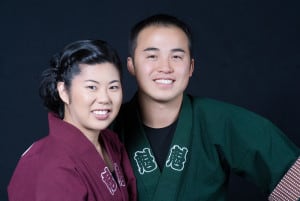
Although Korekara Taiko is new to Young Audiences’ roster this year, chances are that if you’ve seen taiko on a stage or at a school near Portland, you’ve witnessed Co-Directors Michelle Fujii & Toru Watanabe in action. As the education wing of UNIT SOUZOU, Korekara Taiko brings the art of and energy of taiko to schools and students across Oregon. Want to try your hand at–or shall we say on–the drums? Join Korekara Taiko during one of their weekly drop-in classes. More in the mood to watch? Catch UNIT SOUZOU on Sunday, January 25 for Mochitsuki, the 18th Annual Japanese American New Year Celebration at Portland State University. We caught up with Michelle and Toru to learn more about their work and artistic practice. To book a performance with Korekara Taiko, contact School Liaison Josephine Kuever at 503-225-5900 x231.

What is your art practice outside of teaching? Taiko resounds in almost every aspect of our lives. Whether it is sharing taiko through teaching in schools, performing within the local community, creating groundbreaking theatre works or offering public taiko classes, we are deeply committed to build creative and imaginative experiences for the art form of taiko.
How long have you taught with Young Audiences? Although Korekara Taiko is new to the roster this school year, we have been performing and teaching at many schools through Young Audiences for the past 9 years. We are truly excited and delighted to debut our new taiko ensemble and performance.

How does Oregon inspire your art making? Oregon’s landscapes reside in many of our taiko compositions. The mountains, waterfalls, parks, waterways are constant inspirations and nourish our creativity. Portland also has a vibrant arts community that supports each other and often encourages us to keep creating and working.
What is one of your earliest art memories? Michelle: I remember a field trip where we were taken to see a youth symphony perform. I was mesmerized how such a large group of performers could blend such beautiful, ornate music all together. It inspired me to pursue music through my childhood and beyond.
What’s the best thing about being a Young Audiences teaching artist? The pure delight of a child when they get to play or see taiko for the first time is a magical moment that warms our hearts. Teachers often tell us that academically challenged students are able to shine through taiko, and take on leadership roles that they haven’t seen within their classrooms. Knowing that taiko can empower students always inspire us.

Why is art important to kids? We’ve experienced firsthand how taiko can be a powerful vehicle to allow kids to express themselves in new ways, realize the power of teamwork (as an ensemble), broaden their world viewpoints and sensitivities, and nourish their imagination.
Who is your art hero now? Michelle: There have been many inspiring mentors within my life, but I think of my grandmother when asked this question. Her delicate watercolor paintings and Japanese dolls fill my family’s homes, and provide an unspoken connection with all of us. One particular watercolor painting depicts the internment camps, where she and many other Japanese Americans were forced to evacuate to during WWII. This painting serves as a reminder that even during these hard times, she still had the will to be creative and express what was happening in her life through art.
What is a favorite memory of creating or performing? Toru: I remember performing at the Salem World Beat Festival. We were one of many different performing groups representing artistic cultures from around the world. Growing up in Japan as a child, I had limited access to an international community. Seeing that taiko could be part of a larger movement past the boundaries of Japan was an eye-opening moment to feel the possibility of how the world could be.

Michelle: Being able to create and perform taiko is such a powerful experience. Although the instrument of taiko has a history that spans centuries, the style of taiko playing that we perform, kumi-daiko (ensemble drumming), is a post-WWII modern artistic expression. There are still so many unexplored possibilities, and I am motivated to be part of an emerging and evolving art form. I remember creating my first solo taiko performance, CHOKING, where I explored one simple question – “Who Am I?” It took me through a journey of looking at my family history, my lineage and my reflections of being a fourth generation Japanese American. Taiko has enabled me to become curious, and find a way to truly express myself.
If you weren’t an artist, what would you be? Toru: I would open my own ramen food cart. When I toured extensively as a professional dancer/actor with theatre company, Warabi-za, I tried the various styles of ramen in all 47 prefectures of Japan. I’m passionate to make homemade ramen.
Stay up-to-date with all things taiko, find classes, and see a schedule of upcoming performances at: www.unitsouzou.com. And for the taiko newbie, check out this amazing performance video:
